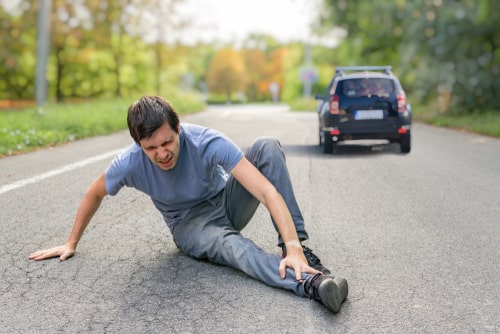Education
Hit and Run Psychology: What Makes Good People Flee Accident Scenes?
Published
2 days agoon

Why do drivers flee after traffic accidents? The numbers tell a disturbing story. Recent data shows that roughly 5 out of 10,000 drivers have a hit-and-run violation on their record. The situation looks even grimmer as nearly six people die in hit-and-run crashes daily across the country.
A hit-and-run crash happens when a driver leaves the accident scene without sharing information or waiting for law enforcement. The problem keeps getting worse. Research shows that drivers flee the scene in about 11% of serious crashes and 20% of fatal accidents. The National Highway Traffic Safety Administration’s data reveals that hit-and-run drivers cause over 20% of pedestrian deaths nationwide.
Fear makes many drivers run from these crashes. But what makes ordinary, law-abiding citizens take such drastic steps? This piece will get into the psychological, emotional, and situational factors behind hit-and-run decisions. We’ll also look at what it all means for fleeing drivers and how to pursue both prevention and justice.
The emotional and psychological triggers behind fleeing
The human brain processes trauma in complex ways, especially when chaos ensues during traffic accidents. These psychological mechanisms help explain why do people hit and run even though they’d normally follow the law.
Fight-or-flight response in accidents
A collision triggers your body into high gear. Your brain sets off an acute stress response that floods your system with adrenaline. This natural shock absorber numbs pain and focuses attention on emergency actions. Your body reacts with a racing heartbeat, sweat, and shaking as it gets ready to face danger or run from it.
This survival mechanism takes a toll on your thinking. The rush of stress hormones can cloud your judgment and decision-making. A person who usually thinks clearly might make snap choices they’d never think over when calm — like running away from an accident.
Acute stress and decision paralysis
The first adrenaline rush often leads many people into what experts call acute stress — a quick stress response triggered by emergencies. Studies show 55% of accident victims feel moderate to severe anxiety right after a crash.
This acute stress shows up through physical signs like feeling faint, dizzy, and hot. It also brings psychological reactions such as terror, restlessness, and fear of death. These overwhelming emotions can freeze your mind and stop you from thinking straight. Research links high stress levels to poor decision-making and reduced awareness of what’s happening around you.
Shame, guilt, and fear of judgment
The emotional impact goes deeper:
Shock and disbelief
Intense fear and anxiety
Overwhelming guilt and shame
Fear of others’ judgment
Drivers who leave accident scenes often make poor risk assessments. The fear of staying and facing consequences outweighs moral and legal duties. Many people freeze up at the thought of being judged by friends, family, or strangers on the road.
Research shows people feel guilty even in accidents that aren’t their fault. This explains why drivers who run away often tell themselves the crash wasn’t that bad or someone else will help the victim.
Situational and legal pressures that influence hit-and-run behavior
Drivers often flee accident scenes for psychological and practical reasons. The pressure of the situation can overwhelm them, leading to poor choices.
Driving without insurance or license
Financial struggles explain why do people hit and run. The number of uninsured drivers nationwide reached 14% in 2022, up from 11.1% in 2019. These drivers know that staying at an accident scene might result in lawsuits, heavy fines, or a suspended license.
The statistics paint a clear picture – 82% of uninsured drivers can’t afford car insurance or own vehicles that don’t work. Insurance costs jumped 20% between June 2022 and June 2023, which forced more drivers to take the risk of driving without protection.
Fear of DUI or outstanding warrants
Impaired drivers face a tough choice after accidents. DUI violations come with harsh penalties including:
- Heavy fines
- License revocation
- Possible jail time
Many impaired drivers run away to dodge DUI charges. Notwithstanding that, runners end up facing multiple criminal charges – both for leaving the scene and driving under the influence.
Immigration status and legal residency fears
Legal status concerns push many drivers to flee from hit-and-run accidents. Undocumented drivers worry about deportation if they talk to authorities after a crash.
Personal injury claims don’t trigger immigration enforcement, and ICE rarely deports people who participate in civil cases. Scared drivers might not know these legal facts during crisis moments.
Employer-owned or stolen vehicles
Drivers using borrowed vehicles sometimes run away because they worry about the owner’s reaction or insurance problems. This fear becomes much worse with stolen vehicles, where staying means getting arrested immediately.
People who steal cars tend to drive dangerously and cause serious damage in accidents.
The aftermath: what fleeing drivers and victims face
Running away from an accident scene changes lives forever. Both drivers and victims face consequences that go way beyond the reach and influence of that split-second choice to leave. The choice creates a messy tangle of legal, financial, and emotional problems.
What happens to hit and run drivers legally
Hit and run drivers face different penalties based on how bad the accident is. New York law can fine property damage cases up to $250 with 15 days in jail. Accidents with injuries become misdemeanors or felonies. Drivers who cause serious injuries get Class E felony charges that come with up to four years in prison and $5,000 in fines. The worst cases that lead to death can put someone behind bars for seven years.
These convictions don’t just end with the punishment. Drivers lose their licenses, get criminal records, and their insurance premiums skyrocket.
Challenges for victims when the driver is unknown
Victims struggle with unique problems when drivers take off. Proving another driver’s involvement becomes a nightmare. Insurance companies start asking questions about whether another car was really there or if the victim caused their own accident.
Time isn’t on the victim’s side either. Wisconsin gives people just three years to wrap up their cases, including finding the driver who ran. This means victims need to jump into action right away to gather evidence and file reports.
Role of uninsured motorist coverage
Uninsured motorist (UM) coverage saves the day in hit-and-run cases. This insurance helps pay for medical bills, lost wages, and other damages when nobody can find the driver who caused it all. UM coverage doesn’t usually need deductibles for injury claims, but vehicle repairs under collision coverage still do.
How victims can still seek justice
Victims aren’t completely out of options. Quick documentation is key — taking photos of the damage, getting witness statements, and recording accident scene details makes future claims stronger. Traffic cameras and dashcam footage are a great way to get evidence to catch drivers who run.
If nobody can find the driver, victims can still get money through:
- Personal Injury Protection (PIP) for medical bills whatever caused the crash
- Collision coverage to fix the car
- Uninsured motorist claims to recover more damages
Some cases involve drivers who claim they didn’t realize there was an accident until later. Understanding the legal implications and how to respond properly can make a major difference in the outcome. Getting a personal injury attorney early also helps victims secure the compensation they deserve.
Can hit-and-runs be prevented?
Public awareness and education
Hit-and-run prevention campaigns have shown clear results. Florida’s Hit-and-Run Awareness campaign teaches drivers about their responsibilities after crashes and the consequences of fleeing the scene. These efforts remind everyone that staying at the scene saves lives. Yes, it is important to know that drivers must stop right away at crash scenes on both public and private property.
Stricter penalties and enforcement
Tough laws strongly discourage hit-and-runs. The Aaron Cohen Life Protection Act now requires at least four years in prison for drivers found guilty of fatal hit-and-runs since 2014. These penalties make drivers think twice about fleeing, even when they face other legal troubles.
Use of surveillance and traffic cameras
Technology plays a bigger role in prevention and accountability today. Speed cameras have cut speeding by 94% where they’re installed. Places with speed cameras in 2022 saw 14% fewer injuries and deaths compared to areas without them. Red light cameras help make sure drivers stop at signals and reduce crash risks.
Encouraging responsible driving behavior
Creating a culture of responsible driving helps prevent these incidents. Dashcams discourage potential offenders and provide important evidence if crashes happen. Defensive driving techniques like staying alert and keeping safe distance from other vehicles add more protection against hit-and-run accidents.
Conclusion
The psychology behind hit-and-run accidents shows how emotions, mental state, and practical concerns all mix together. Fear stands without doubt as the main reason — people are scared of legal trouble, money problems, or what others might think. When trauma hits, our fight-or-flight response kicks in and messes up clear thinking. This pushes normally law-abiding people to make quick decisions they’ll wish they hadn’t.
The situation itself puts huge pressure on drivers. People without insurance, those driving drunk, or those worried about immigration status feel a strong urge to run. In spite of that, running away almost always makes things worse than staying would have.
Hit-and-run crashes create problems that spread way beyond the crash itself. Victims struggle to get justice when they can’t find the driver. Runners who get caught face tough legal punishment — felony charges, jail time, and problems that last forever.
We need to put our full support behind prevention. Better public awareness, tougher enforcement, and new tech like traffic cameras help reduce these incidents. Personal responsibility matters most. Safe driving habits, proper insurance, and making the right choice even under extreme stress can make all the difference.
Human nature tells us to run from danger. But our legal and moral duty after accidents must come first. The quick relief from running away doesn’t compare to the damage it does to victims and the trouble runners face later. The choice to stay at accident scenes shows more than just following laws – it shows basic human decency and responsibility to our community.

Blockchain Nodes – The Quiet Machines That Keep Web3 Alive

Courtney Taylor Olsen: Everything to Know About Elizabeth Olsen’s Half-Sister

First Blood Rambo Jacket: Style Guide for a Bold Look

Why You Need a Simple Budget App in 2025

Where Is Opal Stone Perlman Now? The Story of Ron Perlman’s Ex-Wife

Beyond Words: Understanding and Responding to Non-Verbal Communication

Creative Ways to Use Party Balloons at Outdoor Dubai Events

Why Modern Data Foundations Drive Enterprise Innovation

How Does Cryptocurrency Work: Blockchain, Tokens, and Crypto Trading

Where Is Sydney Brooke Simpson Today? Rare Updates and Surprising Facts

Curious About JOI Database? Read This First Before You Click Anything

Should You Use Wooflix in 2025? Honest Review and Best Alternatives

Jacqueline Bernice Mitchell: The Inspiring Story of Jerry Rice’s Ex-Wife

Where Is Noelle Watters Now? Jesse Watters’ Ex-Wife’s Life After Divorce

ECMISS: The Intelligent System Behind Smarter Everything

Who Is Marlene Knaus? The Untold Story of Niki Lauda’s First Wife

Alisande Ullman Today: What Happened After Her Divorce from Leslie Nielsen?

Who Is Raquel Pedraza? Meet Taylor Fritz’s Tennis Star Ex-Wife

Where Is Anne Steves Now? The Truth About Rick Steves’ Ex-Wife

Is F2Movies Safe to Use? The Truth Nobody Tells You

Blockchain Nodes – The Quiet Machines That Keep Web3 Alive

Courtney Taylor Olsen: Everything to Know About Elizabeth Olsen’s Half-Sister

First Blood Rambo Jacket: Style Guide for a Bold Look

Why You Need a Simple Budget App in 2025

Where Is Opal Stone Perlman Now? The Story of Ron Perlman’s Ex-Wife

Beyond Words: Understanding and Responding to Non-Verbal Communication

Creative Ways to Use Party Balloons at Outdoor Dubai Events

Why Modern Data Foundations Drive Enterprise Innovation

How Does Cryptocurrency Work: Blockchain, Tokens, and Crypto Trading

Where Is Sydney Brooke Simpson Today? Rare Updates and Surprising Facts
Categories
Trending
-

 Entertainment3 months ago
Entertainment3 months agoCurious About JOI Database? Read This First Before You Click Anything
-

 Entertainment3 months ago
Entertainment3 months agoShould You Use Wooflix in 2025? Honest Review and Best Alternatives
-

 Celebrity2 months ago
Celebrity2 months agoJacqueline Bernice Mitchell: The Inspiring Story of Jerry Rice’s Ex-Wife
-

 Celebrity2 months ago
Celebrity2 months agoWhere Is Noelle Watters Now? Jesse Watters’ Ex-Wife’s Life After Divorce
